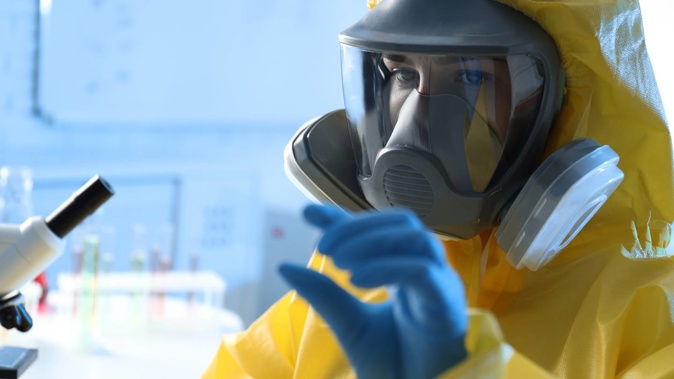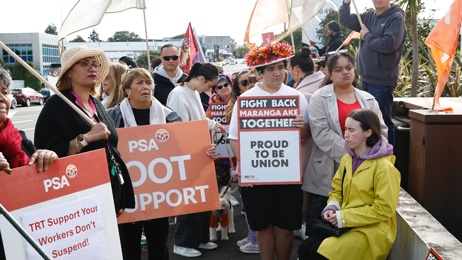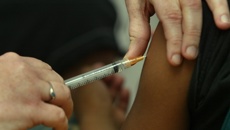
Scientists say they are traumatised after safety monitors designed to protect them from dangerous exposure to a cancer-causing chemical were removed for eight months.
Staff at the Anatomic Pathology Service, run by the Auckland District Health Board, in Mt Wellington claim they experienced dizziness, itchy throats, fatigue, headaches and on occasion had to take days off sick.
They claim they told management about their symptoms but that they felt bullied after they were repeatedly dismissed.
"We could get cancer in ten years time and no one would have taken responsibility, we feel abused and dismissed," one staff member said. The Herald on Sunday agreed not to reveal the identity of any of the, less than 20, workers because they were scared of losing their jobs.
The chemical, formaldehyde, was used at the lab to preserve body parts staff were studying to investigate causes and effects of disease and injury.
Monitors had been at the lab since at least 2015 to measure workers' exposure to the chemical.
In March 2020, WorkSafe reviewed the standard for formaldehyde in workplaces across New Zealand and found there was "sufficient evidence" showing high exposure could cause cancers in the nasal area and leukemia.
All employers were expected to gradually drop the amount of formaldehyde their workers were exposed to before new standards take effect this November.
Of all 750 work-related deaths in 2015, cancer was responsible for half. And of about 5000-6000 of all work-related hospitalisations about 2000 were linked to cancer.
But in March last year, the monitors were removed from the pathology lab by DHB management, who told the Herald on Sunday it was because they were inaccurate.
Over the following months, visits by health and safety experts from three different agencies identified problems at the lab.
- In July 2021, International Accreditation New Zealand did a routine safety assessment of the lab and identified eight issues which did not comply with their basic standards.
IANZ's recommendations - which were later cited by a DHB health and safety representative in a report leaked to the Herald on Sunday - included the DHB resolving; the "dangerously cramped" work-space conditions, inadequate ventilation, no early warning system of dangerous chemicals, exposure levels above the new standards and non-compliant hazardous material storage.
They also advised the DHB to address workplace culture of staff being discouraged to report incidents.
- Also in July, WorkSafe visited to do a general safety assessment of the lab. The later DHB report said staff told them that the formaldehyde monitors had been removed and they had for years been experiencing symptoms due to high levels of exposure.
WorkSafe sought to determine what management was doing to monitor exposure and ensure workers are being protected from formaldehyde, the DHB report said.
- In October 2021, the DHB's own health and safety staffer visited the lab. In his report, issued the following month, he said staff believed the monitors were removed because they had to evacuate on a regular basis because they were picking up exposure levels beyond the new recommendations. It "caused significant disruption to work flow".
The removal came across as "oppressive and not understandable" by staff, the report said.
Staff felt they couldn't openly raise concerns as they had been repeatedly dismissed in the past and they were scared it could affect their job security, the report said.
It said no course of action was taken to check the monitors were being used correctly as per the manufacturer's specifications.
"No interim Safe Standard of Work and Evacuation Protocol or any temporary means of monitoring formaldehyde levels was put in place.
"Staff naturally became increasingly concerned about the seeming lack of care that the employer was taking in regard to their health and safety."
He also issued several Provisional Improvement Notices (PIN) in November citing "really serious safety issues" to do with reporting exposure spills and dumping the chemical down the drain, which the DHB have complied with.
The monitors were returned in November after the report was released.
But a DHB spokeswoman disputed the staff's version of events, telling the Herald on Sunday the monitors were found to be inaccurate and were removed at the recommendation of external experts. "They were not removed due to work piling up."
They said there were other monitoring systems in place, such as wearable badges which measured levels in line with the new standards.
However, staff claimed to the Herald On Sunday the other systems did not track "real-time exposure" and results took two to three weeks to process. The DHB did not comment on whether this was correct.
"Technically, it doesn't give you any idea of what the formaldehyde level is and it may also not capture a spike so technically you are already exposed before you know it," a worker said.
"All we want is to be safe at work and know that we won't die from it someday, it's taken a huge emotional toll on all of us and our families," another worker said.
The DHB said they returned the monitors "as an added reassurance, to supplement the recommended local and personal monitoring systems."
A WorkSafe spokeswoman said they were not aware of monitors being removed until they were asked to review PINs issued by the health and safety representative in November.
"WorkSafe understands other controls were in place, and information provided showed acceptable levels."
When the Herald on Sunday asked IANZ if they felt the DHB was doing enough to ensure staff were protected and new standards were being met, a spokeswoman said, "there was insufficient evidence to support a robust safety plan".
Auckland DHB director of provider services Mike Shepherd said the majority of external expert recommendations had been implemented and the rest were in progress.
"Regarding the space and ventilation, we have put in place short to medium-term measures including moving some work areas to another location to increase space for the team. Meanwhile, a business case for a permanent expansion and new ventilation systems has been approved."
Shepherd said the DHB acknowledged "we could have engaged with our people in better ways about how we were addressing their concerns".
The DHB took allegations of bullying or harassment very seriously, he said.
"We encourage anyone who experiences or witnesses harassment, bullying or discrimination to speak up, so that we can support our people to ensure everyone can work in a safe, healthy environment."
Staff said comments about the DHB caring about their mental wellbeing were "bulls***".
"If they cared they wouldn't have dismissed us over and over again. We tell them we are experiencing symptoms and they do nothing."
When asked why they decided to stay, staff said they had thought about it, and some had left, but they loved their job and were good at it. "Why should we give up what we love?".
The reports follow controversy with Auckland DHB's hospital-based pathology lab back in 2017. The Herald revealed it lost its accreditation for examining tissue samples because levels of formaldehyde got so high staff were evacuating daily.
Workplace Relations and Safety Minister Michael Wood said he was aware that WorkSafe was notified of concerns relating to formaldehyde at the lab on November 17, last year.
"They responded quickly to these concerns by issuing Improvement Notices requiring the necessary fixes. Since then they have had ongoing interactions with Auckland DHB to ensure that there are appropriate processes in place to look after the health and safety of staff."
Chief executive of the Cancer Control Agency, Te Aho o Te Kahu, Diana Sarfati said the agency had a close working relationship with WorkSafe, which has focused its efforts to begin to reduce work-related carcinogens. "Cancers are a significant driver of work-related harm."
Take your Radio, Podcasts and Music with you









